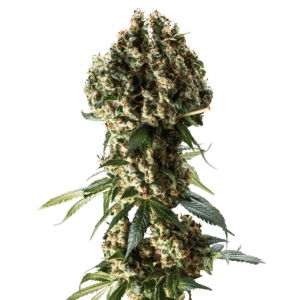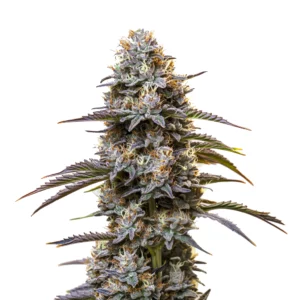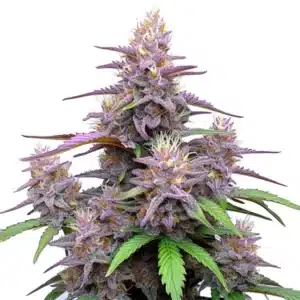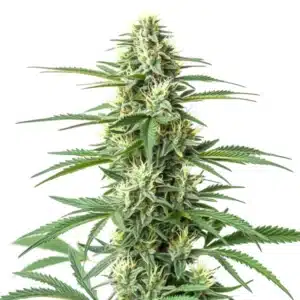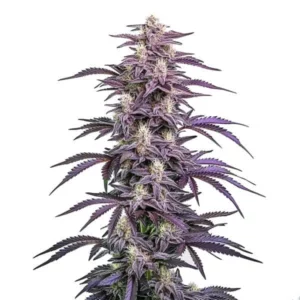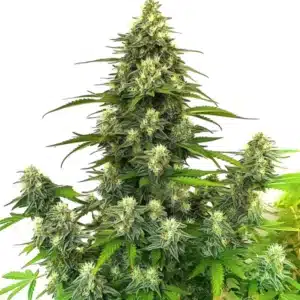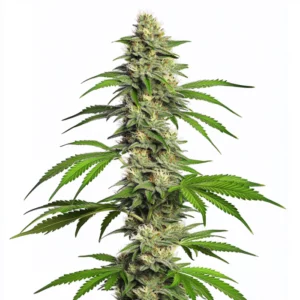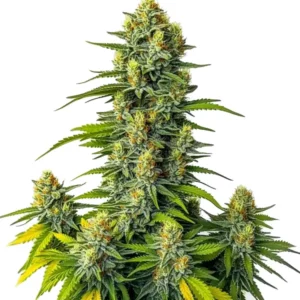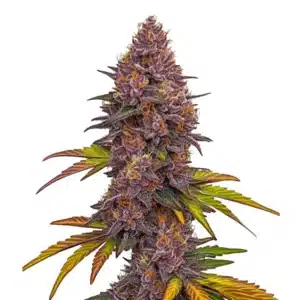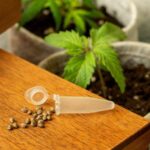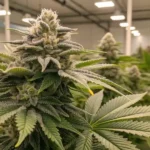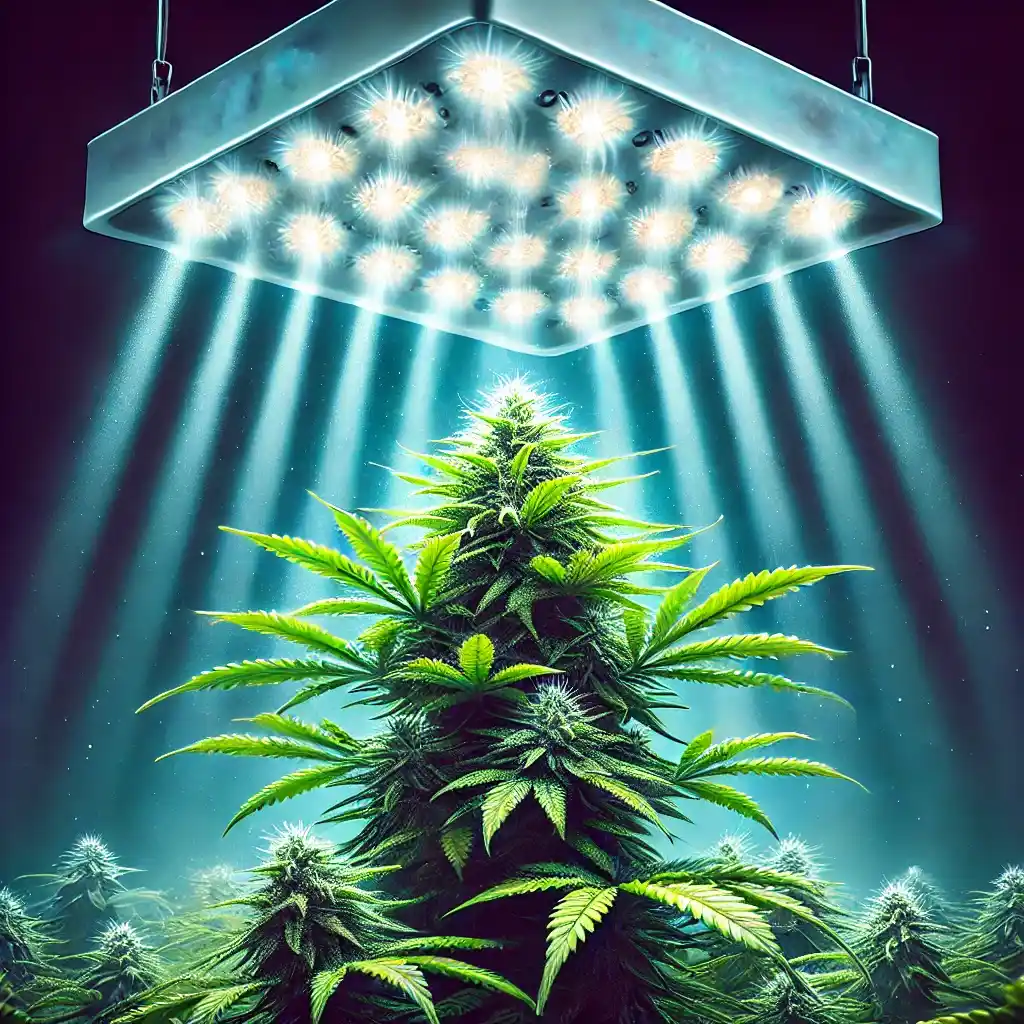
PPFD for Autoflowers: The Key to Maximizing Cannabis Yields
Mastering the concept of PPFD (Photosynthetic Photon Flux Density) is crucial for anyone serious about maximizing their cannabis yields, especially when growing autoflowers. Understanding how to manage PPFD for autoflowers can make the difference between a mediocre harvest and a bountiful, resin-rich yield. This guide will walk you through everything you need to know about PPFD, from its importance in cannabis cultivation to optimizing it for every stage of your autoflower’s growth.
The Importance of PPFD in Cannabis Cultivation
PPFD is a fundamental metric in cannabis cultivation, directly impacting your plant’s ability to photosynthesize and grow. Knowing why PPFD matters and how to measure it can help you fine-tune your growing environment for maximum efficiency and results.
Recommended Strains
Granddaddy Purple
|
|
THC | 25% (High) |
|
|
Type | Feminized |
|
|
Yield | Medium |
|
|
Phenotype | 70% Indica / 30% Sativa |
Granddaddy Purple Auto
|
|
THC | 16% - 19% (Medium) |
|
|
Type | Autoflowering |
|
|
Yield | Medium |
|
|
Phenotype | 80% Indica / 20% Sativa |
What is PPFD and How is it Measured?
PPFD, or Photosynthetic Photon Flux Density, measures the amount of light (specifically, photosynthetically active photons) that hits a square meter of your plant’s canopy per second. It’s expressed in micromoles per square meter per second (µmol/m²/s). In simpler terms, PPFD tells you how much usable light your plants are receiving at any given moment.
For autoflowers, which have a fixed growth cycle, managing PPFD effectively is crucial. Unlike photoperiod strains, which can be kept in the vegetative stage as long as needed, autoflowers progress from seedling to flowering based on time rather than light cycles. This makes it imperative to ensure they receive the optimal light intensity at every stage of growth.
PPFD is typically measured using a PAR (Photosynthetically Active Radiation) meter, which gauges the intensity of light in the 400-700nm wavelength range the spectrum most beneficial for photosynthesis. By regularly measuring PPFD in your grow space, you can adjust your lighting setup to ensure your autoflowers are getting exactly the right amount of light they need to thrive.
The Function of PPFD in Photosynthesis
Photosynthesis is the process by which plants convert light energy into chemical energy, fueling their growth and development. PPFD directly influences this process by determining the amount of light available for photosynthesis.
For cannabis plants, including autoflowers, an optimal PPFD level ensures that the photosynthesis process runs efficiently. If the PPFD is too low, photosynthesis slows down, leading to weaker, slower-growing plants with smaller yields. On the other hand, if PPFD is too high, it can cause light stress, leading to nutrient deficiencies, stunted growth, or even light burn.
Understanding the role of PPFD in photosynthesis allows growers to provide their autoflowers with the right light conditions to maximize their energy production, leading to healthier plants and more abundant harvests.
Why PPFD Matters for Cannabis Plants
PPFD is not just a number; it’s a critical component of your cannabis plant’s environment. For autoflowers, which have a predetermined lifecycle, managing PPFD effectively is even more important. Since autoflowers transition from vegetative growth to flowering based on time, they don’t have the luxury of extended vegetative periods to recover from poor light conditions.
Ensuring that your autoflowers receive the optimal PPFD at each stage of growth helps to maximize their potential. During the vegetative stage, proper PPFD levels promote vigorous growth, allowing the plants to develop strong branches and a dense canopy. As the plants move into the flowering stage, maintaining the right PPFD levels supports robust bud development, resulting in larger, more potent flowers.
Understanding and optimizing PPFD for autoflowers, especially when aiming for the right PPFD for autoflowers, requires accurate measurement and the ability to make precise adjustments.

Promos & Deals
Optimal PPFD Levels for Different Growth Stages
Different stages of growth require different PPFD levels to maximize your autoflower’s potential. Knowing these optimal levels and how to achieve them is key to a successful grow.
PPFD Requirements During Seedling Stage
During the seedling stage, autoflowers are delicate and require lower light intensity to avoid stress and encourage healthy root development. A PPFD range of 100-200 µmol/m²/s is ideal during this phase. This gentle light level helps the seedlings establish a strong root system without overwhelming them with too much light.
Providing a lower PPFD at this stage also prevents stretching, which can occur if seedlings are exposed to too much light too soon. Stretching leads to elongated, weak stems that may struggle to support the plant as it matures. By maintaining an appropriate PPFD, you can ensure that your seedlings grow compact and strong, setting the foundation for a healthy plant.
Vegetative Stage: Achieving the Right PPFD
As your autoflowers transition into the vegetative stage, they require more light to fuel their rapid growth. Increasing the PPFD to around 400-600 µmol/m²/s during this phase supports the development of a robust canopy and strong branches, which are essential for supporting the weight of the buds that will form later.
At this stage, the plants are actively photosynthesizing and producing the energy needed for both vegetative growth and the eventual flowering process. Ensuring that your autoflowers receive the correct PPFD during the vegetative stage allows them to build a solid structure, which is crucial for maximizing yield and quality during the flowering stage.
It’s important to monitor the plants for signs of light stress during this stage. While a higher PPFD is beneficial, too much light can lead to issues such as leaf burn or nutrient lockout. Adjusting the light intensity or distance from the canopy can help fine-tune PPFD levels and keep your plants healthy.
PPFD for Maximizing Bud Development in Flowering Stage
The flowering stage is where your autoflowers begin to produce the buds that will eventually be harvested. To maximize bud development, the PPFD should be increased to 600-900 µmol/m²/s, depending on the strain and environmental conditions.
During flowering, the plants focus on developing dense, resinous buds. An optimal PPFD level ensures that the plants have enough light to fuel this process, leading to larger, more potent flowers. However, it’s important not to exceed the recommended PPFD range, as too much light can cause foxtailing, where the buds stretch and lose their density.
Balancing PPFD during the flowering stage is key to producing high-quality cannabis with a strong aroma, flavor, and potency. Monitoring your plants and making adjustments as needed will help you achieve the best results.
Balancing PPFD with Light Duration and Spectrum
PPFD is just one aspect of your lighting strategy. To truly optimize your autoflower grow, it’s important to consider how PPFD interacts with light duration and spectrum.
How Light Spectrum Affects PPFD
Light spectrum refers to the range of wavelengths emitted by your grow lights. Different wavelengths of light affect cannabis plants in different ways, and understanding how spectrum interacts with PPFD can help you fine-tune your grow.
Blue light (400-500nm) is most effective during the vegetative stage, as it promotes compact growth and strong leaf development. When paired with an appropriate PPFD, blue light helps autoflowers establish a solid foundation for flowering.
Red light (600-700nm), on the other hand, is more beneficial during the flowering stage, where it enhances bud development and increases resin production. By adjusting the light spectrum alongside PPFD, you can tailor your lighting setup to the specific needs of your plants at each stage of growth.
Full-spectrum LED lights are a great option for autoflower cultivation, as they provide a balanced mix of wavelengths that support growth throughout the entire life cycle. When using full-spectrum lights, it’s important to monitor PPFD to ensure that your plants are receiving the right intensity of light across all wavelengths.
Adjusting Light Schedules to Optimize PPFD
In addition to spectrum, the duration of light exposure plays a crucial role in determining the overall PPFD your plants receive. For autoflowers, which don’t rely on light cycles to trigger flowering, you have the flexibility to adjust light schedules to optimize PPFD.
Many growers use an 18/6 light schedule (18 hours of light followed by 6 hours of darkness) to achieve optimal autoflower PPFD 18/6 conditions and ensure consistent and high PPFD throughout the plant’s life cycle. This schedule allows for maximum light exposure while giving the plants a period of darkness to rest and recover.
In some cases, growers may opt for a 20/4 or even a 24/0 schedule to increase PPFD further. However, it’s important to monitor your plants closely, as too much light can lead to stress and diminish returns. The key is to find the balance that works best for your specific strain and growing conditions.
Adjusting light schedules to optimize PPFD can lead to faster growth, more robust plants, and ultimately, higher yields. By experimenting with different schedules and monitoring the results, you can fine-tune your lighting strategy to achieve the best possible outcomes.
The Interplay Between PPFD and DLI
DLI, or Daily Light Integral, is another important metric to consider when optimizing PPFD for autoflowers. DLI measures the total amount of light your plants receive over the course of a day, combining both PPFD and light duration.
The interplay between PPFD and DLI is crucial for understanding how much light your plants actually need. For example, a high PPFD combined with a long light schedule can result in a very high DLI, which might be more than your plants can handle. Conversely, a lower PPFD with a longer light duration can still provide an adequate DLI for healthy growth.
Knowing the relationship between PPFD and DLI allows you to make more informed decisions about your lighting setup, ensuring that your plants receive the optimal amount of light for each stage of growth. By balancing these two factors, you can create an environment that supports vigorous growth and maximizes yield potential.
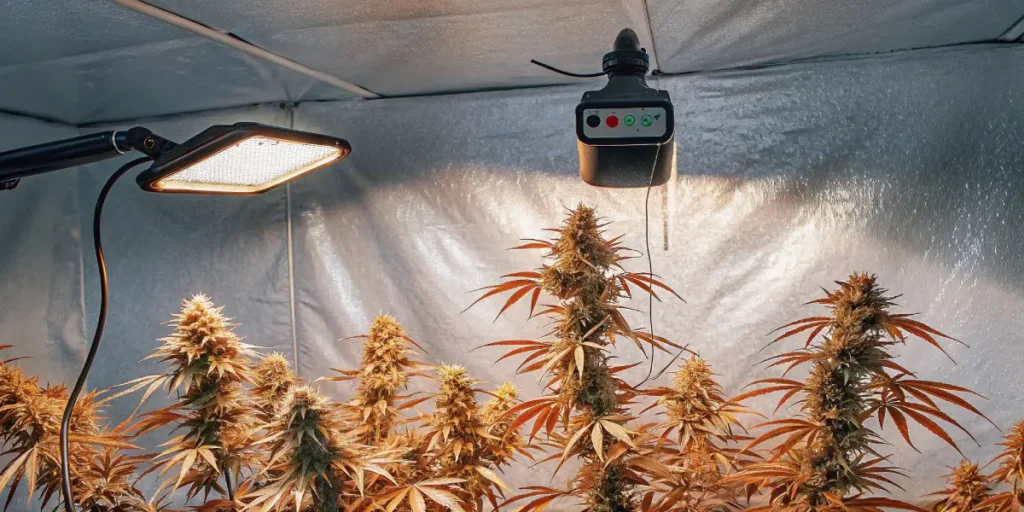
Measuring and Adjusting PPFD in Your Grow Space
Understanding and optimizing PPFD for your autoflowers requires accurate measurement and the ability to make precise adjustments. This section will guide you through the tools and techniques needed to measure PPFD effectively and how to adjust it to meet your plants’ needs.
Tools and Techniques for Measuring PPFD
To accurately measure PPFD in your grow space, you’ll need a PAR (Photosynthetically Active Radiation) meter. This device measures the light intensity within the 400-700nm wavelength range, which is crucial for photosynthesis. PAR meters are essential for ensuring that your ppfd autoflower receive the optimal light intensity at each stage of their growth.
When using a PAR meter, it’s important to take multiple readings across different areas of your grow space, especially at the canopy level where your plants are actively absorbing light. Since light intensity can vary depending on the distance from the light source and the type of grow lights used, measuring PPFD at various points ensures even light distribution.
To use the PAR meter:
- Turn off any fans or other devices that might affect light measurement.
- Place the sensor of the PAR meter at the canopy level of your plants.
- Take readings from different spots across the canopy to get an average PPFD value.
- Record the measurements to track changes over time or after making adjustments to your lighting setup.
By regularly measuring PPFD, you can ensure that your plants are consistently receiving the right amount of light. This practice allows you to make informed decisions about adjusting light intensity and positioning to optimize plant growth.
How to Adjust Light Intensity to Meet PPFD Needs
Once you’ve measured the PPFD in your grow space, the next step is to adjust the light intensity to meet your autoflowers’ specific needs. Here’s how you can do that:
- Adjusting Light Height: The simplest way to change PPFD is by adjusting the height of your grow lights. Moving the lights closer to the canopy increases the PPFD, while raising them reduces it. However, be cautious not to place the lights too close, as this can cause light burn.
- Dimming or Boosting Light Output: Many modern LED grow lights come with dimming capabilities, allowing you to adjust the light intensity without changing the light’s position. Dimming is particularly useful during the seedling stage when lower PPFD levels are needed, and boosting the output can help during the flowering stage.
- Using Reflective Materials: Enhancing light distribution in your grow space with reflective materials like Mylar can increase the effective PPFD without increasing the light’s output. This method helps direct more light toward the plants, making your grow setup more efficient.
- Adding or Reducing Light Sources: Depending on your setup, you may need to add more lights to increase PPFD or reduce the number of lights if the intensity is too high. This method is particularly useful in large grow spaces or when working with different strains that require varied light levels.
By making these adjustments, you can fine-tune the PPFD to provide your autoflowers with the ideal light environment, leading to healthier growth and better yields.
Ensuring Even PPFD Distribution Across the Canopy
Even light distribution across the canopy is crucial for ensuring that all parts of your plants receive adequate light. Uneven PPFD can result in some areas of the plant receiving too much light while others don’t get enough, leading to inconsistent growth and reduced yields.
To ensure even PPFD distribution:
- Position Lights Strategically: Arrange your grow lights so that they provide uniform coverage across the entire canopy. In larger grow spaces, multiple lights might be necessary to achieve this.
- Use Light Spreaders: Light spreaders or diffusers can help distribute light more evenly across the canopy. These tools are especially useful in setups where a single light source might create hotspots with excessively high PPFD.
- Train Your Plants: Techniques like LST (Low-Stress Training) or topping can help create an even canopy, allowing all parts of the plant to receive the same amount of light. This practice not only improves PPFD distribution but also maximizes light penetration to lower branches.
- Regularly Rotate Plants: In smaller grow spaces, manually rotating your plants can help ensure even light exposure, particularly if you’re using fixed lights that can’t be easily adjusted.
By focusing on even PPFD distribution, you can prevent issues like light stress or uneven bud development, leading to a more consistent and high-quality harvest.
Troubleshooting PPFD Issues in Cannabis Grows
Even with careful planning, issues with PPFD can arise, affecting the health and productivity of your autoflowers. This section will help you identify and correct common PPFD-related problems.
Signs Your PPFD is Too Low or Too High
One of the first steps in troubleshooting PPFD issues is recognizing the signs that your PPFD levels are either too low or too high. Autoflowers respond visibly to changes in light intensity, and understanding these signs can help you take corrective action quickly.
Signs of Low PPFD:
- Stretching: When the PPFD is too low, plants may stretch as they search for more light. This results in long, weak stems and a sparse canopy.
- Slow Growth: A lack of sufficient light energy slows down photosynthesis, leading to sluggish growth and delayed development.
- Pale or Yellowing Leaves: Insufficient light can cause chlorosis, where leaves turn yellow due to a lack of chlorophyll.
Signs of High PPFD:
- Leaf Burn: Excessive light intensity can cause leaf tips to burn, showing up as brown or crispy edges.
- Nutrient Deficiencies: High PPFD increases the plant’s metabolic rate, which can lead to faster nutrient uptake and potential deficiencies if not managed properly.
- Foxtailing: In the flowering stage, too much light can cause buds to stretch, forming spindly “foxtails” instead of dense, compact buds.
Recognizing these signs early allows you to adjust your lighting setup and prevent further damage to your plants.

Correcting PPFD Imbalances for Healthier Plants
Once you’ve identified PPFD issues, the next step is to correct these imbalances. Here’s how you can adjust your grow setup to bring PPFD levels back into the optimal range.
For Low PPFD:
- Increase Light Intensity: Lower the lights closer to the canopy or switch to higher-wattage bulbs to boost PPFD.
- Extend Light Duration: If increasing intensity isn’t an option, consider extending the light cycle to increase the total amount of light your plants receive daily.
- Supplement with Additional Lights: Adding more light sources can help raise PPFD levels, particularly in larger grow spaces or areas with weak coverage.
For High PPFD:
- Raise Light Fixtures: Increasing the distance between the lights and the canopy can reduce the intensity of light hitting the plants.
- Dim Lights: If your lights have dimming capabilities, reduce the output to lower PPFD.
- Improve Ventilation: High PPFD can cause heat stress, so ensuring proper airflow and temperature control can mitigate some of the negative effects.
By making these adjustments, you can correct PPFD imbalances and create a more stable environment for your autoflowers, leading to healthier growth and better yields.
Managing PPFD in Variable Environmental Conditions
Environmental factors like temperature, humidity, and CO2 levels can all impact how your plants respond to PPFD. Managing PPFD in variable conditions requires a dynamic approach to lighting and environmental control.
Temperature and Humidity:
- High temperatures can exacerbate the effects of high PPFD, leading to heat stress and light burn. Conversely, low temperatures can slow down metabolism, making it harder for plants to utilize the available light.
- Similarly, high humidity can reduce transpiration, affecting nutrient uptake, while low humidity can increase the risk of light burn. Using dehumidifiers, humidifiers, and proper ventilation can help maintain optimal conditions.
CO2 Levels:
- In environments with enhanced CO2 levels, plants can handle higher PPFD levels because they can photosynthesize more efficiently. If you’re supplementing with CO2, you can safely increase PPFD to boost growth and yield.
- In natural CO2 environments, maintaining a balanced PPFD is crucial, as excessive light can lead to stress without the enhanced photosynthetic capacity provided by CO2 supplementation.
By carefully managing these environmental factors, you can ensure that your plants are getting the most out of the light you provide, even as conditions change.
Comparing PPFD Requirements for Different Cannabis Strains
While this article focuses on PPFD autoflowers, it’s important to understand how PPFD requirements vary across different types of cannabis strains. Tailoring PPFD to the specific needs of each strain can help optimize growth and yield.
How Indica, Sativa, and Hybrid Strains Respond to PPFD
Different cannabis strains have varying light requirements based on their genetics and growth characteristics. Understanding these differences can help you tailor your PPFD strategy to each strain.
Indica Strains:
- Indicas typically grow shorter and bushier, with dense foliage. They often require lower PPFD levels compared to sativas, especially during the vegetative stage. A PPFD range of 400-600 µmol/m²/s is generally sufficient to promote healthy growth without causing light stress.
Sativa Strains:
- Sativas tend to grow taller with longer internodal spacing, requiring higher PPFD levels to penetrate their canopies effectively. During the vegetative stage, sativas may benefit from PPFD levels of 500-700 µmol/m²/s. In the flowering stage, sativas can often handle higher PPFD levels, up to 900 µmol/m²/s, to maximize bud production.
Hybrid Strains:
- Hybrids, which combine characteristics of both indica and sativa strains, have varied PPFD needs depending on their genetic makeup. It’s essential to observe each hybrid’s growth pattern and adjust PPFD accordingly, aiming for a range that suits its dominant traits.
PPFD Considerations for Autoflowers vs. Photoperiod Strains
Autoflowers and photoperiod strains have distinct growth cycles, which influences their PPFD requirements. Understanding these differences is key to optimizing light exposure for each type.
Autoflowers:
- Autoflowers have a predetermined lifecycle, typically ranging from 8 to 12 weeks from seed to harvest. Due to this short growth period, maintaining optimal PPFD levels throughout the entire cycle is crucial. Autoflowers generally thrive with PPFD levels starting at 100-200 µmol/m²/s during the seedling stage, increasing to 400-600 µmol/m²/s in the vegetative stage, and reaching 600-900 µmol/m²/s during flowering.
Photoperiod Strains:
- Photoperiod strains can be kept in the vegetative stage for extended periods, allowing for more flexibility in managing PPFD. These plants can handle a wider range of PPFD levels, with lower levels during the early vegetative stage and higher levels during flowering. The flexibility in light schedule allows growers to fine-tune PPFD over a longer period, optimizing for both growth and yield.
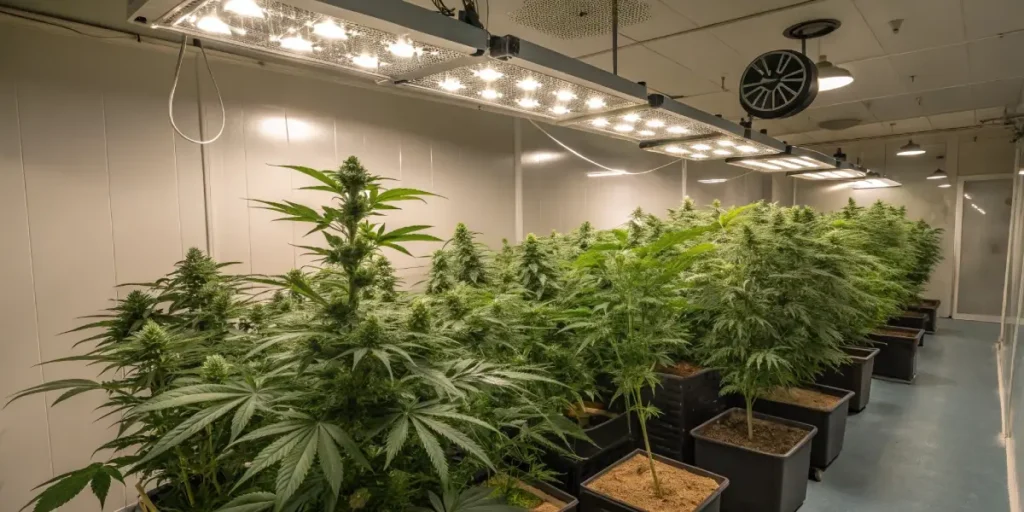
Tailoring PPFD to Strain-Specific Growth Characteristics
Each cannabis strain has unique growth characteristics that influence how it responds to light. Tailoring PPFD to these specific traits can help maximize the potential of each strain.
Canopy Density:
- Strains with dense canopies may require higher PPFD levels to ensure light penetrates through the foliage. Training techniques like topping or LST can help open up the canopy, allowing for more even light distribution.
Bud Structure:
- Strains that produce dense, compact buds may benefit from slightly lower PPFD levels during the late flowering stage to prevent foxtailing and ensure the buds develop their full potential. Conversely, strains with airy buds might require higher PPFD to encourage more resin production.
Leaf Structure:
- Broad-leafed indica strains may shade lower parts of the plant more than narrow-leafed sativas. Adjusting PPFD to account for this shading can help ensure that all parts of the plant receive adequate light, promoting uniform growth.
By understanding and adapting to the specific needs of each strain, you can optimize PPFD to enhance growth, yield, and overall plant health.
Integrating CO2 Supplementation with High PPFD Levels
CO2 supplementation is an advanced technique that allows cannabis plants to utilize higher PPFD levels more effectively. When CO2 levels are increased, plants can photosynthesize at a faster rate, which in turn allows them to handle more light without experiencing stress.
Benefits of CO2 Supplementation:
- Enhanced Growth: With higher CO2 levels, plants can produce more energy through photosynthesis, leading to faster growth and increased yields.
- Better Light Utilization: CO2-enriched environments allow plants to thrive under higher PPFD levels, maximizing the potential of your grow lights.
Implementing CO2 Supplementation:
- To integrate CO2 with your high PPFD setup, you’ll need a CO2 tank, regulator, and controller to maintain optimal CO2 levels (usually between 1200-1500 ppm). By carefully monitoring and adjusting both CO2 and PPFD, you can create an environment that promotes vigorous growth and maximizes your autoflowers’ yield potential.
Long-Term Benefits of Consistent PPFD Management
Consistent PPFD management offers long-term benefits that go beyond a single grow cycle. By maintaining optimal PPFD levels throughout each stage of growth, you can improve overall plant health, increase yields, and enhance the quality of your harvests.
Improved Plant Health:
- Consistent PPFD management ensures that your plants receive the right amount of light at each stage of growth, reducing stress and promoting healthy development. Over time, this leads to stronger, more resilient plants that are better equipped to handle environmental challenges.
Increased Yields:
- By optimizing PPFD, you can maximize photosynthesis, leading to more robust vegetative growth and larger, denser buds during flowering. Consistently high yields over multiple grow cycles contribute to a more profitable and sustainable operation.
Enhanced Quality:
- Proper PPFD management not only increases quantity but also improves the quality of your cannabis. Plants grown under optimal light conditions produce more resin, higher cannabinoid content, and better terpene profiles, resulting in a superior final product.
FAQs
What is the ideal PPFD for an autoflower micro grow?
For an autoflower micro grow, the ideal PPFD ranges from 100-200 µmol/m²/s during the seedling stage, 400-600 µmol/m²/s in the vegetative stage, and up to 600-900 µmol/m²/s during flowering. Maintaining these levels helps optimize growth in small spaces and maximizes bud production.
How can I measure PPFD accurately in a micro grow setup?
You can measure PPFD in your autoflower micro grow using a PAR meter. Place the sensor at the canopy level and take readings across different spots to ensure even light distribution. Regular measurements allow you to adjust light height, dimming, and positioning to maintain optimal PPFD levels throughout the grow.
Why is PPFD management important in an autoflower micro grow?
PPFD management is critical in an autoflower micro grow because these plants have a fixed life cycle and limited recovery time. Providing the right light intensity at each stage ensures healthy growth, prevents light stress, and leads to higher yields, even in compact growing environments.


